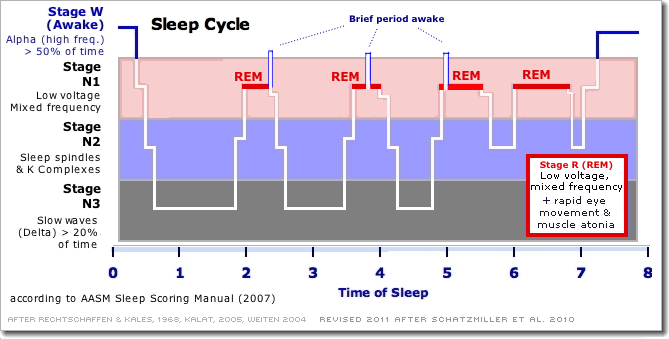![[Brain Image]](../graphics/head_space.gif)
PSY 340 Brain and Behavior
Class 22: Stages of Sleep & Brain Mechanisms [OUTLINE]
|
|
PSY 340 Brain and Behavior Class 22: Stages of Sleep & Brain Mechanisms [OUTLINE] |
|
A. Sleep and Other Interruptions of Consciousness
- Sleep
- Coma
- Vegetative State (aka "Unresponsive Wakefulness Syndrome" or "Persistent Visceral State")
- Some patients may actually be experiencing "cognitive motor dissociation (CMD)" in which they can perform cognitive tasks which are detected by fMRI or EEG.
- Minimally Conscious State
- Brain Death = no evidence of activity in cerebrum or cerebellum (see image)
- Persistent coma
- Absence of brainstem reflexes
- Lack of ability to breathe independently
B. The Stages of Sleep
electroencephalograph
(EEG)![[Electroencephalograph]](../graphics/eeg.gif) |
|
Stage W (awake)
|
![[Brain Wave: EEG
Tracings]](../graphics/brainwaves.jpg) |
When we are asleep,
|
|
![[Polysomnograph Sleep Study]](../graphics/Polysomnography.jpg)

Non-REM Sleep
includes Stages N1 to N3
|
Stage
R (REM (Rapid Eye Movement) Sleep) (= "paradoxical" sleep in animals who do not move eyes) |
![[Real Life Sleep]](../graphics/reallifesleep.png)
C. Brain Mechanisms of Wakefulness & Arousal
pontomesencephalon
(reticular formation)Acetylcholine (ACh) & glutamate = excitatory basal forebrain
(anterior to hypothalamus)Acetylcholine (ACh) = excitatory [green tracts]
GABA = inhibitiory [red tracts]hypothalamus
Histamine
Orexin (Hypocretin)locus coeruleus
(dorsal pons)Norepinephrine (blocks REM sleep) dorsal raphe nucleus Serotonin
D. Sleep and the Inhibition of Brain Activity
- GABA inhibits signaling in localized areas of cerebral cortex
- Sleep paralysis
- Sleepwaking (somnambulism)
E. Brain Function in REM Sleep: PGO Waves
F. Sleep Abnormalities ("Parasomnias")
- PGO waves (see figure on right)
- spinal cord inhibits motor neurons associated with large muscles
- Activity decreases in prefrontal cortex, primary visual cortex, & motor cortex, but increases in temporal & parietal cortex
- Acetylcholine (ACh) moves sleeper into REM
- Carbachol stimulates ACh
- Serotonin & norepinepherine interrupt or shorten REM
Insomnia = not sleeping enough due to (1) difficulty falling asleep (onset insomnia), (2) frequent awakening during sleep (maintenance insomnia), or (3) waking up too early (termination insomnia) Sleep Apnea = intermittent stopping of breathing during sleep due to obstruction of the airway or CNS problems
Narcolepsy Includes one or more of these symptoms:
- Gradual/sudden onset of sleepiness
- Cataplexy: muscle weakness while remaining awake. Often triggered by strong emotions
- Sleep paralysis: inability to move when falling asleep or waking up
- Hypnagogic hallucinations: dreamlike experiences at the beginning of sleep.
Equivalent to REM-like sleep intruding into the awake state
Treated with stimulants, e.g., Ritalin or Cylert
- orexin (hypocretin) => Humans with narcolepsy do not have these cells in the hypothalamus (perhaps due to an autoimmune disorder).
Periodic Limb Movement Disorder
- during NREM sleep individual moves legs and sometimes arms every 20-30 seconds for minutes or hours.
- NOT "restless leg syndrome"
- Treated with tranquilizers
REM Behavior Disorder
- during REM sleep individual moves vigorously or violently (kick, punch, etc.); dreams of violent nature
Night Terrors
- Crying & screaming but NOT usually awakening.
- Happens mostly to children in the first third of sleep.
Sleep Talking
- We all do it
Sleepwalking
- usually seen in children 2-12 years old
- usually harmless with occasional accidents
- no danger to wake the sleepwalking person up
- no treatment other than making sure that the person's environment is safe
The first version of this page was posted on March 6, 2005.